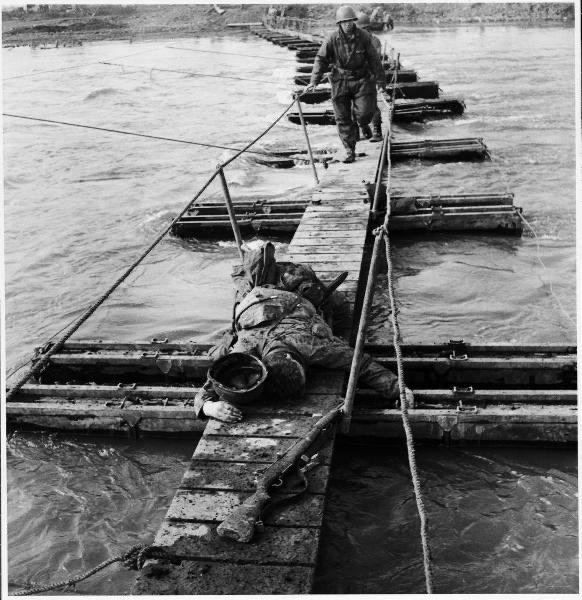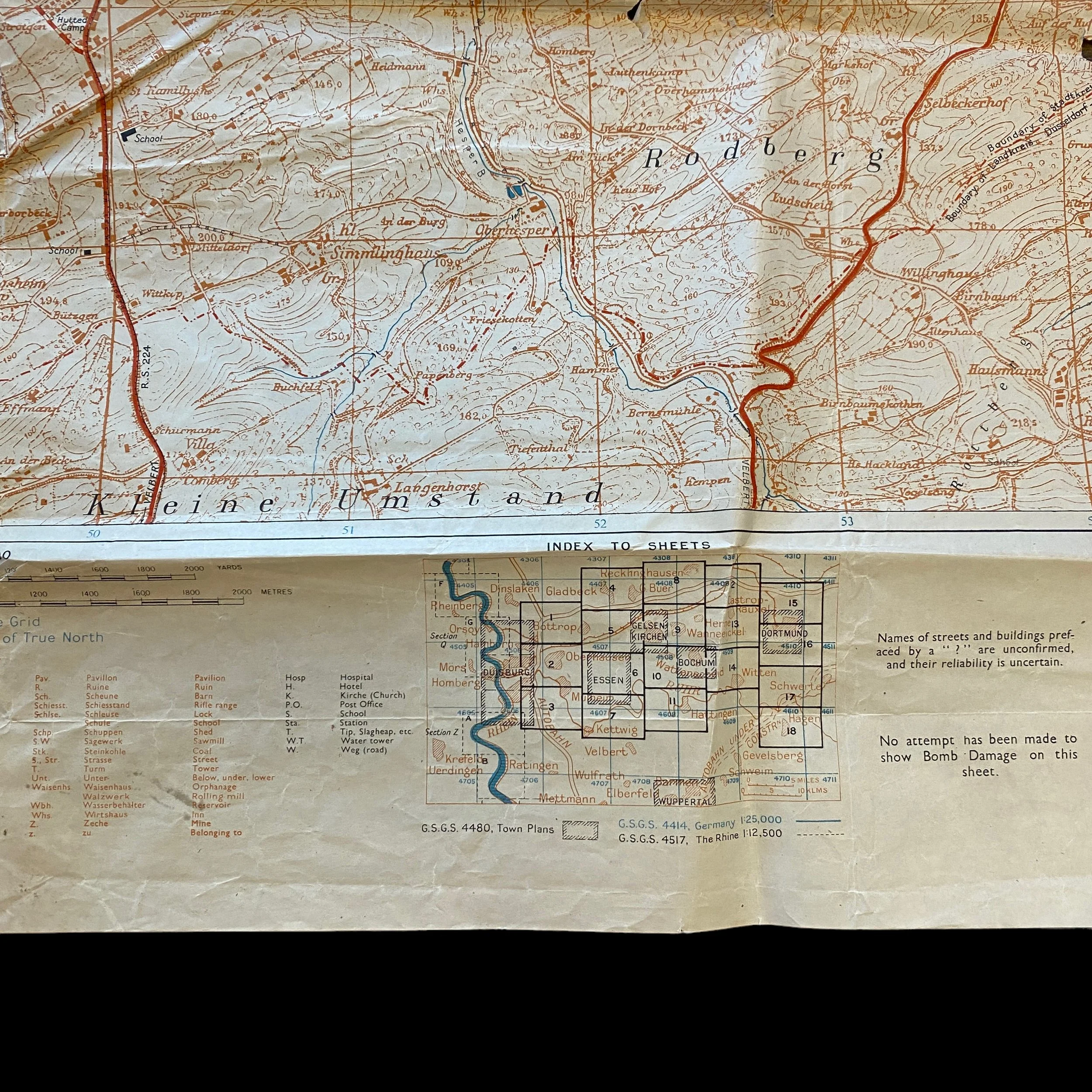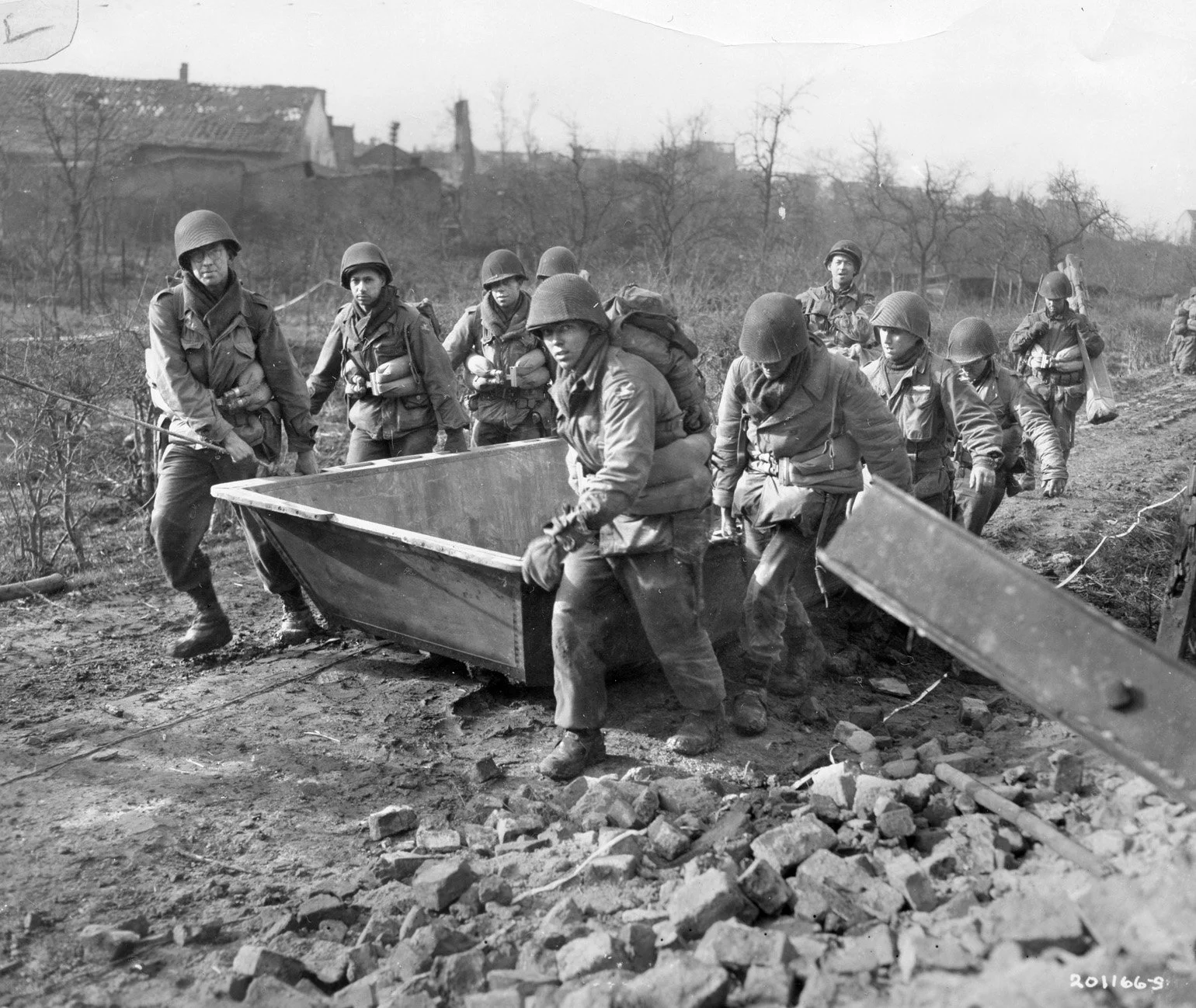VERY RARE! WWII U.S. Ninth Army Operation Grenade Roer River Crossing Combat Assault Map















































VERY RARE! WWII U.S. Ninth Army Operation Grenade Roer River Crossing Combat Assault Map
Comes with C.O.A.
This incredibly rare and museum-grade WWII combat assault map was used by the U.S. Ninth Army (commanded by Lieutenant General William Hood Simpson) during Operation Grenade (the crossing of the Roer/Ruhr River). In two weeks of furious fighting in February and March 1945, the Ninth U.S. Army bulldozed its way over the Roer River on its drive to the Rhine marking the Invasion of Germany. This operations map shows the crossing of the Roer River near Essen.
On 9 February, the U.S. Ninth Army—operating under Field Marshal Bernard Montgomery's Anglo-Canadian 21st Army Group since the Battle of the Bulge—was to cross the Roer and link up with the Canadian First Army, under Lieutenant-General Harry Crerar, coming from the Nijmegen area of the Netherlands in Operation Veritable, which had started at 05:00 on 8 February. However, once the Canadians had advanced, the Germans opened the sluice gates of upstream dams (Rur Dam and Urft Dam). This stopped the Americans from crossing as planned. It had been anticipated that the Germans would try to do this, and that General Omar Bradley's U.S. 12th Army Group could capture them in time to stop the flooding.
During the two weeks that the river was flooded, Hitler would not allow Generalfeldmarschall Gerd von Rundstedt to withdraw behind the Rhine, arguing that it would only delay the inevitable fight. He ordered him to fight where his forces stood. Those forces comprised the 15th Army, commanded by Gustav-Adolf von Zangen, and the 1st Parachute Army, commanded by Alfred Schlemm.
The Ninth Army was finally able to cross the river on 23 February. By then, other Allied forces were also close to the Rhine. German forces west of the Rhine during operations Veritable, Blockbuster and Grenade lost 90,000 men, of which more than 50,000 became prisoners of war (POW). Allied casualties amounted to some 23,000 men.
U.S. TROOPS ENCIRCLE GERMAN ARMY IN RUHR POCKET:
n the spring of 1945 senior leaders of the Third Reich were on edge. On Germany’s Eastern Front, the tracks of Soviet mechanized armor and the boots of their infantry could be heard approaching the outskirts of the epicenter of Nazism, Berlin. On the Western Front, elements of the U.S. First Army under the overall command of Gen. Omar Bradley’s U.S. 12th Army Group had succeeded in establishing a bridgehead on the east bank of the Rhine River after capturing the Ludendorff Bridge at Remagen, 35 miles south of the cathedral city Cologne, on March 7, 1945. First Army soldiers got busy advancing northward into the enemy’s heavily populated military-industrial heartland, the Ruhr, defended by German Field Marshal Walter Model’s Army Group B. Their advance formed the southern pincer of the Ruhr envelopment (see map below). The northern pincer was formed by the U.S. Ninth Army, since the Battle of the Bulge (December 16, 1944, to January 25, 1945) assigned to British Field Marshal Bernard Law Montgomery’s 21st Army Group. Days before, on March 23–27, 1945, Monty’s British-Canadian-American forces had crossed the Lower Rhine in the Wesel area in Operations Plunder and Varsity. Thus the lead elements of two U.S. armies, First and Ninth, stood ready on March 28, 1945, to begin a massive envelopment of upwards of 400,000 German troops in the so-called Ruhr Pocket.
The reduction of the encircled enemy by the U.S. Ninth Army, reattached to Bradley’s 12th Army Group, began at the top of April when lead elements of the two U.S. pincers converged near Lippstadt in the eastern Ruhr. Troops from the U.S. First Army, 90 miles to the south, solidified the ring around Army Group B some 4 days later. Outmanned, outgunned, low on ammunition and fuel, the Germans skillfully delayed or resisted the American advances for days. But on this date, April 14, 1945, the U.S. First and Ninth Armies managed to split the Ruhr Pocket into an east part and a tinier west part.
The turning point in combat came the same day. Having lost contact with its units, the German 15th Army, the larger of the two armies that comprised Model’s Army Group B, capitulated. Model dissolved the whole of his army group the next day, April 15. Then he ordered noncombatant personnel, Hitler Youth units, and the Volkssturm, a ragtag home guard consisting of 16- to 60-year-olds who had escaped being swept up by understrength units of the Wehrmacht (German armed forces), to discard their uniforms and makeshift armbands and head home as best they could.
On April 16 the remnants of 2 armies, 5 corps, and 19 mostly weaponless Wehrmacht divisions surrendered en masse to U.S. forces after Germany’s leader for the past 15 years, Adolf Hitler, denied Model’s request for either an airlift of weapons and other supplies (too risky) or permission to break out of “Festung Ruhr,” Fortress Ruhr (stay put). Organized military resistance in the Ruhr Pocket ceased on April 18. Two days later Hitler associate Joseph Goebbels denounced Army Group B as traitors. Unwilling to submit to German or Allied arrest—the United Nations Commission for the Investigation of War Crimes was busy at the time identifying German war criminals—Model, the monocled model of a proud Prussian field marshal, died by his own hand on the afternoon of April 21, 1945, nine days before his commander-in-chief did the same in the Fuehrerbunker under the rubble of his diabolical Thousand Year Reich.
By April 4, 1945, the encirclement was complete. Among the millions of desperate, displaced, and destitute Ruhr civilians trapped inside the pocket were the German 15th Army in the east and, in the west, the 5th Panzer Army, both armies under the overall command of Field Marshal Walter Model, head of Army Group B. Half of Model’s soldiers fielded infantry weapons, the other half pistols only. The soldiers had food provisions for 3 weeks, notwithstanding Hitler’s expectation that Model’s armies would hold out for months in their fortified stronghold and tie up hundreds of thousands of Allied soldiers with promised help from the German 12th Army, which was never available, tied up at the moment in trying to break the Soviet siege of the Reich capital. By April 11 the egg-shape pocket, originally 35 by 75 miles wide, had fractured in the east, shriveling a third or more. It was half that size 3 days later when U.S. First and Ninth Armies bisected the egg in the Hagen-Witten area, which lay between Essen and Dortmund. On April 16 the remnants of mostly weaponless fighters surrendered to U.S. forces, encouraged by American loudspeakers calling on German soldiers to give up the last-ditch fight of a war long lost. Some of the younger and older men trekked home. The bulk of the fighting men, between 317,000 and 325,000, were herded into temporary POW enclosures near Remagen.